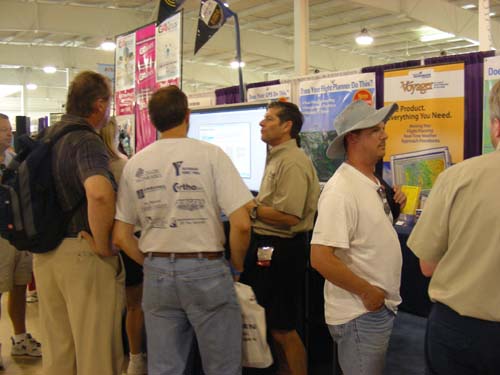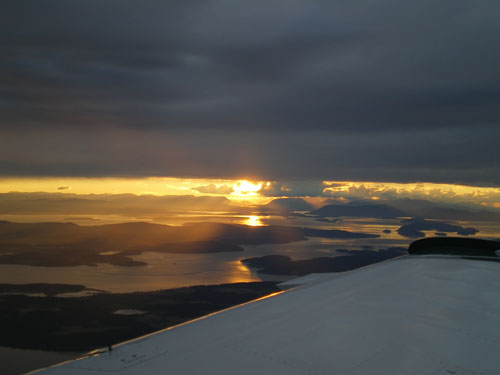|
First let me say thanks to all of you, our customers, with a special welcome to those of you who joined us at EAA's AirVenture in Oshkosh. We had a great time in Oshkosh. Not only did we sign up a record number of new customers, but we got to see many long-time customers again and put a face to a name (or email address) for many of you. And the weather was good for a change (that is, neither too hot nor too humid), so we all came back refreshed and energized rather than hot, sweaty, and tired. Finally, many of us got to fly home in a Bonanza and experiment with Voyager running on several tablet PCs. More on this later in All Airways Lead to Oshkosh (Part II: The Flights). Flight Log is a recurring newsletter for all Voyager users, with the latest Voyager news, tips and tricks. I'm very interested in your feedback, either to the newsletter or to Voyager itself. Please send any comments or suggestions to me directly at SteveP@SeattleAvionics.com. Back issues of Flight Log are available from our Web site at http://www.seattleavionics.com/Newsletters
As you can see, our booth was usually very crowded at Oshkosh. Here, John Rutter is giving a demo of Voyager on the big screen. This second picture is here to remind us about one of the reasons we fly GA; you can't get pictures like this from a 757 screaming along at FL390. New Version 3.67 Voyager 3.67 was released on Wednesday, August 22. This new version is available to ChartData subscribers for no additional cost. If Voyager didn't already mention that an update was available, select Update Application from the Tools menu to download it. Version 3.67 is what we call a maintenance release in that it fixes a few minor bugs and changes some features in subtle ways rather than adding many new features. Most of the feature enhancements are in the GlassView module. They make it easier to select objects on the Chart, easier to scroll the Chart, faster to switch to the Fuel Prices theme, and faster to show the Scanned Charts while in flight. Perhaps best of all, you can launch Voyager directly into GlassView mode, bypassing all dialog boxes and downloads (new /QuickFly command-line switch). All in all, there are more than 50 changes between versions 3.65 and 3.67, so there's probably something for everyone. Read the details. Labor Day Specials — $99 Any Voyager Module What would Labor Day be without sales? We like sales as much as anyone, so we're offering a big one. The usual price for all Voyager modules is $198. Just until Monday, September 3, all modules are 50% off, or just $99. If you're a FreeFlight user, there's no more excuse not to get 3D wind-optimized autorouting, fuel prices on the Chart, export to popular handheld GPS devices, true scanned FAA Sectionals, etc. If you're instrument-rated and you don't already have SmartPlates, a one-time purchase of SmartPlates gets you a lifetime of free approach plates and frees you from seeing the word "Jeppesen" on your Visa bills. http://www.seattleavionics.com/buy and use Coupon Code LaborDay2007. No More Trial Versions We like to try new things at Seattle Avionics and our latest is to switch away from a long-standing policy of allowing trial versions of all Voyager modules. That policy began in 2004 with Voyager 1.0, before we had Voyager FreeFlight and before we had online demos. Today, with FreeFlight available and already treated by many people as a long-term trial version of the full Voyager system, we just don't think it's necessary to offer trial versions of the full product any more. However, we do think we need to update some of our online demos, so look for revised online demos with narration in the next few weeks. Please let me know if you have any thoughts about this.
Last month, I began a two-part story about flying to Oshkosh from Seattle in a Bonanza. If you missed the first part about the pre-flight planning, you can read it from the back issues of Flight Log on our Web site. This month, I'll talk about the actual flights, both to OSH and back from OSH to Seattle. All Good Plans... Just to recap, our original plan was to fly from PAE (north of Seattle) to HLN (Helena, MT) to MKA (Miller, SD) then on OSH or ATW (Appleton, WI). We had to make a small change in the initial flight plan because John Rutter, the owner of the Bonanza, had to fly to a birthday bash that a friend threw for himself in Sun River (yes, it's a hard life...). Therefore, a couple of us took a flight on the Dark Side and booked a commercial flight from Seattle to Boise (BOI) to meet up with John enroute. There, we planned to fly from BOI to GCC (Gillette-Campbell County) and, from there, keep the stop at MKA (home of perhaps the cheapest fuel in the West at $3.25) and on to Wisconsin. If you haven't realized it by now, we really use the cheap fuel finder now built into Voyager's autorouter. The flight from BOI to GCC went about as planned. We wanted to run Voyager entirely on batteries the whole way so we used a pair of Motion Computing tablets rather than plug-in anything. One tablet was an LE1600 (the larger Motion tablet) and the other was the smaller Motion LS800 with a solid-state drive. As expected, Voyager ran well on both machines but there was disagreement over which machine was better for the flight. John likes the larger tablet while I prefer something lighter than the latest Harry Potter book so use the LS800. Not only do I prefer the smaller size, but the solid state drive made me feel more comfortable at altitudes that were, well, somewhat above the 10,000 ft. hard drive limit of the spinning drive in the LE1600. To me, the system also seemed faster than the LE1600. The LE1600 has a slightly faster processor than the LS800 but the solid-state drive in the LS800 is markedly faster, giving the system an overall faster feel. Once on the ground in Gillette, we headed out in the FBO's courtesy car to dinner. Being better at navigating in the air than on the ground, it took us a bit to find a good restaurant. After dinner we headed back to the FBO, downloaded current weather, then took off towards MKA. The problem was, with two tablets, we had two pilots planning flights and comparing notes. Thus, the simple matter of planning the next leg became a mini version of a UN Security Council meeting and, by the time we finally had wheels up, two and a half hours had elapsed since landing at GCC. The moral of the story: bring just one tablet PC and let the Pilot-In-Command be in command. Once we got in the air, we found headwinds worse than predicted. That coupled with impending darkness made our original goal of MKA a poor choice (a little too small for a comfortable night landing). Here Voyager and tablets again showed their worth versus the plane's panel-mounted Garmin 430 because we were looking for an airport with long, easy-to-find runways and cheap fuel. By just looking at the charts on Voyager, with fuel prices right on the screen, we were able to 'discover' CNB (Myers Field) with $3.65 fuel and a decent 4600 ft. lighted runway (Editor's Note: The price has since increased to $3.88 at CNB). We fueled up at the self-serve and got an ice cream from the well-stocked freezer at the all-night FBO. After a quick check of the weather via Voyager we were off again for the final leg. As you might know, no night landings are allowed at OSH during the show (something about people sleeping) so, as expected, we had to land at Appleton (ATW) a short distance away. Thankfully, we had used Voyager to download all the FBO information ahead of time so we were well prepared. As we touched down, the tablet automatically switched into Taxi layout and, with the help of the geo-referenced airport diagram, we were very tired but (almost) at Oshkosh. Samsung vs. Motion We always sell our demo units on the last day of tradeshows to lighten the load home. At OSH, we sold our demo Motion LE1600 and LS800 SSD (Solid State Drive). For the flight home, that left us with a brand-new Motion LE1700 and a Samsung Q1 with a spinning drive (and a ThinkPad laptop if all else failed). The main test during the flight was to see how the small and inexpensive Q1 would do compared to the much larger, much faster, and much more expensive Motion LE1700. Comparing the machines is a little like comparing a Toyota Prius to a Ford Expedition. Yes, they both get you from A to B, but the similarities pale compared to the differences. The Motion LE1700 is a new machine with a state of the art Intel Core 2 Duo processor (two processors on one chip), 2 GB of RAM and a very high-resolution 12.1 inch screen at 1400 x 1024 resolution. The Samsung has a relatively small 7-inch screen with just 800 x 480 resolution and a much slower single-processor CPU. Both had spinning hard drives and the Motion uses a special stylus while the Samsung has a touch screen. The winner? The Samsung Q1 by a landslide. Surprised? The bottom line is that the Q1 just worked while the LE1700 was like taking a rocket-powered drag racer to the corner grocery store. In other words, the LE1700 is simply too much machine for flying — the CPU draws too much power so the battery life is little better than one hour (versus two and a half for the Q1) with the standard battery and no better than two hours even with the extended battery (and this includes lowering the display's brightness). More troubling, since you can always plug the unit in during flight, is that the Motion's screen resolution is far higher than it should be for its relatively small physical size, making all text and graphics small and hard to read. Finally, Voyager 3.6's chart drawing speed is highly dependent on the screen resolution since it draws to a logical canvas nine times larger than the visible screen to enable very rapid scrolling. Thus, the faster CPU in the LE1700 was more than offset by drawing to an area about four times larger than the Samsung Q1. This resulted in overall slower performance than the Q1, albeit with large and beautiful charts. That said, if you primarily want a desktop or laptop replacement with occasional in-flight use, the 1700 is a much better choice than the Q1. And, from all the machines we sell, I still like the Motion LS800 with a solid state drive the best, as the screen is much brighter and a little larger than the Q1, the text is easy to read, and the CPU is a little faster. The solid state drive is critical here, however, as the we no longer sell the Motion LS800 with a standard spinning drive because the unit has a tendency to overhead in hot cockpits. The solid-state drive still gets hot but I've never seen one actually overheat. As always, please send your questions and favorite tips to SteveP@SeattleAvionics.com. A reminder that past Tips and Tricks are
available from our Web site at
Seattle Avionics Software will be showing Voyager at the following upcoming events. Stop by to say hello, see the latest Voyager features, and ask the experts any questions you have about Voyager. Maybe even see Voyager 4.0. October 4-6: AOPA Expo, Hartford, Connecticut. Until next time, happy flying and may all your fuel be cheap.
- Steve Podradchik, CEO (and Editor)
|


